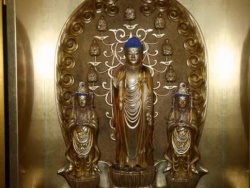Liangzhou
Liangzhou 涼州 (currently: Wuwei 武威, Gansu Province) Tib. Ling chu gser khab/Byang ngos
This initially Chinese prefectural seat on the Silk Road corridor between the Tibetan and Mongol inhabited regions of Inner Asia was a critical zone of contact between different ethnic and political polities across the centuries. Tibetans first attacked Liangzhou as part of the Tibetan Empire's expansion into Inner Asia in 701, and finally captured the city from the Tang Dynasty in 764, only to lose it to the Uyghurs in 808. However, with brief exceptions, from the early ninth to the early eleventh centuries Liangzhou remained in the hands of the Tibetans, one of the last remnant outposts of their once vast Inner Asian empire.
Liangzhou Tibetans maintained good relations with the Song Dynasty from 906 to 1015, often winning titles from the court. However, after a brief period of rule by Uyghur's from 1015 to 1030, Liangzhou became an important regional city in the rising Mi nyag or Xia Empire. Given its culturally Tibetan history, this city remained an important site for Mi nyag Tibetan contact. In the late twelfth and early thirteenth century, it was home to two imperial preceptors (dishi 帝師)--the Tibetan Gtsang po pa Dkon mchog seng ge (?-1218/1219) and Ti shri ras pa Sangs rgyas ras chen (1164/1165-1236)--in the Karma and 'Ba' rom pa Kagyü traditions respectively. The long-term presence of Kagyü monasteries in this region thus must date to this period.
With the collapse of the Mi nyag/Xia Empire to Mongol onslaught in 1227, in 1239 Liangzhou became the headquarters of Köden, son of ögödei Khan. It was from this seat of power that the first Mongol invasion of Tibet was launched in 1240, under the direction of a Tangut named Doorda Darqan. Köden summoned Sa skya Pandita Kun dga' rgyal mtshan (1182-1251) to Liangzhou in 1244, and he arrived in 1246 with his two nephew's 'Phags pa (1235-1280) and Phyag na rdo rje. Although these Sa skya representatives stayed only a short while in Liangzhou, they had a lasting influence on the region. In return for healing Köden from an illness, Sa skya Pandita was given the local temple Sprul pa'i sde (Huanhua si 幻化寺, also known as the White Stupa Temple (Baitasi 白塔寺), located in Dahe xiang 大河鄉. He died and was buried there in 1251. In all, the Sa skya controlled four monasteries spread around the city in the cardinal directions: this temple in the east, in the west Pad mo'i sde (Lianhua si 蓮花寺), in the north Byang rgya mtsho sde (Haizang si 海藏寺, this is the only one to survive to the present), in the south Dbang sde (Guanding si/ Jinta si 灌頂寺/金塔寺). Shortly after his uncle died, 'Phags pa left in 1253 to serve at the court of Qubilai (not yet khan at this time). Around 1256, Karma Pakshi (1206-1283), the second Black Hat Karmapa, also passed through Liangzhou on his way from visiting Qubilai in the south heading north to the court of Möngke Khan in Mongolia. The Kagyü influence in this region, which was quite strong until the visit of the fifth Dalai Lama in 1652 (on his way to the Qing court in Beijing), no doubt benefited from this visit. Although Köden died by 1260 at the latest, his family remained in Liangzhou as the rulers of Hexi (河西) for the duration of Mongol rule.
Sources:
Christopher Beckwith. 1987. The Tibetan Empire in Central Asia, Princeton: Princeton University Press
Patricia Berger. 1994. Preserving the Nation: The Political Uses of Tantric Art in China. In Latter Days of the Law: Images of Chinese Buddhism 85-1850. Lawrence: Spencer Museum of Art, University of Kansas. pp. 89-125
Ruth Dunnel. The Hsia Origins of the Yüan Institution of Imperial Preceptor. Asia Major. Third Series, Vol. 5, part 1, 1992, pp. 85-111
Heather Karmay, Early Sino-Tibetan Art. Aris and Phillips. 1975: 35-42
Luciano Petech. 1983. Tibetan Relations with Sung China and the Mongols. In China among equals: the Middle Kingdom and its neighbors, 10th-14th centuries. Berkeley: University of California Press. pp. 173-204
Wangqian Duanzhi and Jiang Zengli, Sapan yu Liangzhou si da fo si, xerox, pp. 9-13.
Entry by Gray Tuttle, 1/21/07
